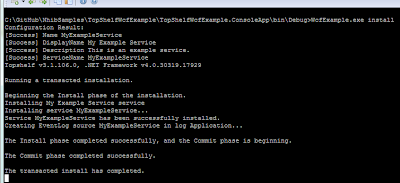In the last post, we saw how to get started hooking things up with Windsor, TopShelf, and NLog. This post will take a look at logging with Windsor and NLog. We'll also look at using a utility called Log2Console to view our log messages as they are generated.
The Packages
This post looks at using the following NuGet packages:
Installing Castle.Windsor-NLog ensures that all the appropriate logging dependencies are included in our application. NLog.Schema adds some Intellisense to help with the NLog.config file.
Initializing the Logger
Windsor's behavior can be extended through the use of facilities. A handy one, available out of the box, is the Logging Facility. We'll be setting up to use NLog as our framework. Windsor is configured to use NLog by adding the appropriate facility:
It is possible to specify various options: config file location, log target, etc. We'll be using the default NLog beahvior which looks for a file called NLog.config in the root directory of the assembly.
Configuring the Logger
Windsor's behavior can be extended through the use of facilities. A handy one, available out of the box, is the Logging Facility. We'll be setting up to use NLog as our framework. Windsor is configured to use NLog by adding the appropriate facility:
container.AddFacility<LoggingFacility>(facility => facility.LogUsing(LoggerImplementation.NLog))
It is possible to specify various options: config file location, log target, etc. We'll be using the default NLog beahvior which looks for a file called NLog.config in the root directory of the assembly.
Configuring the Logger
Adding the NLog.Schema package to a project adds a schema file which can aid in editing the NLog.config file. The NLog wiki is pretty good about documenting the different options. In short, the config is broken into two sections:
- Targets. These describe the formatting, content, and destination of the log message.
- Rules. These describe what gets logged, and to what target the message is sent.
A nifty trick which can be used while you're working on things is to use NLog in conjunction with a utility called Log2Console. To use Log2Console to view log message, you will need to add a receiver. This will allow it to receive messages. First click the Receivers button, then click the Add... button. Add a UDP receiver, leaving the default settings.
After adding the receiver, the NLog.config file will need to be updated. A Chainsaw target will need to be added. There will also need to be the corresponding rule created:
Once it's setup, Log2Console should catch the messages sent to NLog by your application.
Conclusion
This showed a quick and dirty way of viewing log messages in real time. It's something that could be useful while working on applications. Next up will be a look at setting up WCF endpoint in our TopShelf app.










